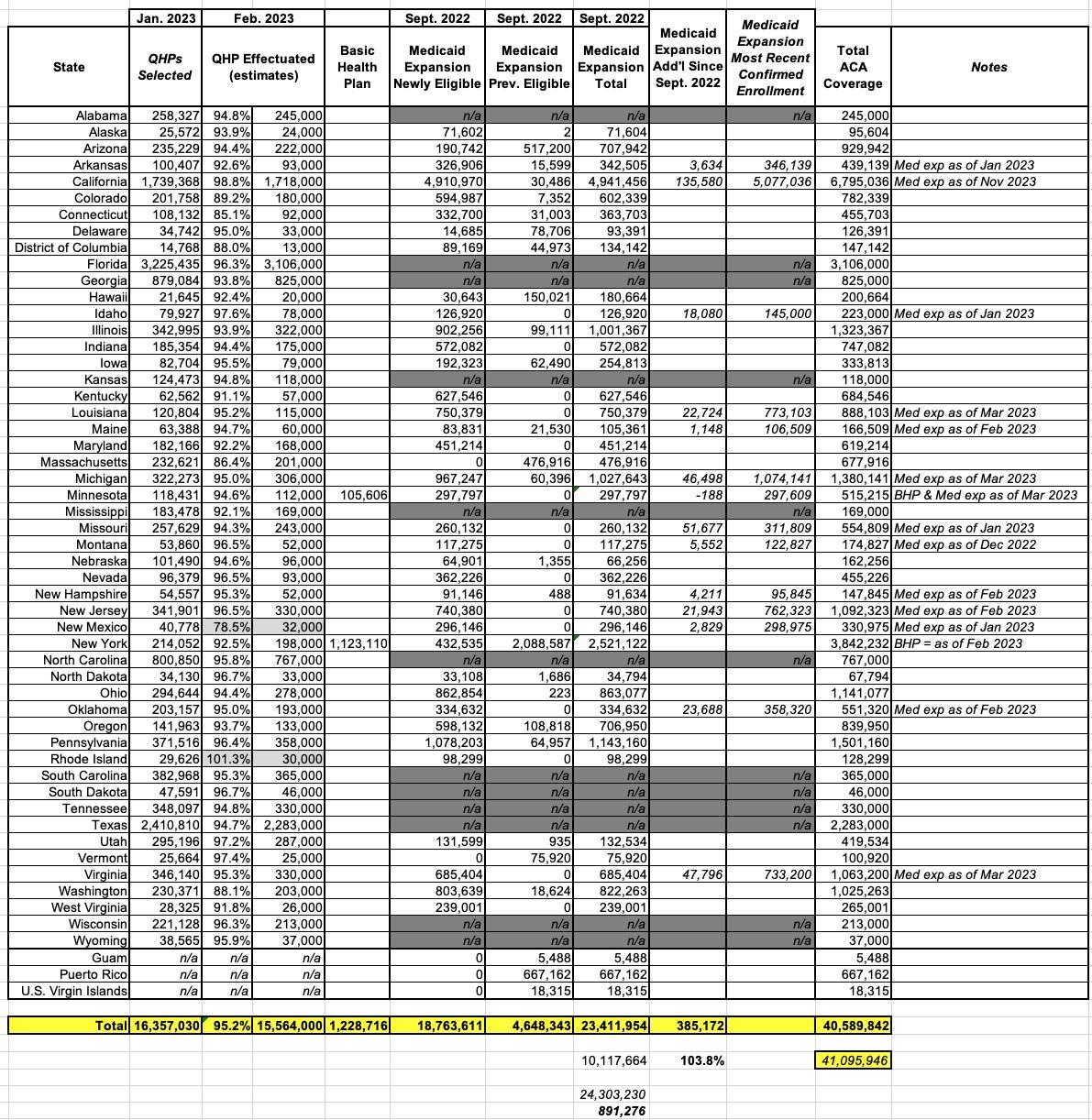ACA coverage has likely broken 41M, and more notes from the ASPE report

Back in late January, I crunched the numbers on the total number of Americans who currently have healthcare coverage directly via the Affordable Care Act. This includes three categories: Exchange-based Qualified Health Plans (QHPs); the Basic Health Plan (BHP) progams in Minnesota and New York; and Medicaid Expansion in the 38 states (+DC) which had implemented it as of that point.
I concluded that the total numbers for each were roughly 15.4 million QHPs, 1.2 million BHPs and 23.5 million Medicaid expansion enrollees, or around 40.1 million people total.
Earlier this week, the Centers for Medicare & Medicaid Services (CMS) confirmed my estimates and even came in slightly higher, at around 40.2 million. They put effectuated QHPs at 15.6 million and Medicaid expansion enrollment at around 23.4 million.
The CMS press release's numbers were based on a study by the Assistant Secretary for Planning & Evaluation (ASPE):
- Marketplaces and Medicaid expansion, programs created by the Affordable Care Act (ACA), have enrolled millions of Americans in participating states since their implementation in 2014.
- Nearly 15.6 million* consumers were enrolled in Marketplace plans as of February 2023 (across all 50 states and the District of Columbia), and 18.8 million people (across 38 participating states and the District of Columbia) were newly enrolled in Medicaid via the ACA’s expansion of eligibility to adults as of September 2022.
- 1.2 million individuals were enrolled in early 2023 in the ACA’s Basic Health Program option, and 4.6 million previously eligible adults gained coverage under the Medicaid expansion by September 2022 due to enhanced outreach, streamlined applications, and increased federal funding under the ACA.
- Across these coverage groups, a total of 40.2 million Americans were enrolled in coverage related to the ACA based on 2022 and early 2023 enrollment data, the highest total on record. This represents 9.3 million more people enrolled than in 2021 (a 30% increase) and 27.6 million more people enrolled than in 2014 (a 219% increase, or more than triple).
- This brief updates our estimate released In April of 2022 where we found more than 35 million people had gained coverage under the ACA. Our current estimate of 40.2 million represents more than 4 million people gaining coverage over the past year.
- Survey results indicate that all 50 states and the District of Columbia have experienced substantial reductions in the uninsured rate since 2013, the last year before implementation of the ACA.
Again, for the most part this all lines up pretty closely with my January estimates on all counts.There's a few things to note, however.
For starters, there's the distinction between plan selections and effectuated enrollment. As the ASPE report notes:
There are two related measures of Marketplace enrollment. The first is plan selections, and the second is effectuated enrollment. At the end of open enrollment periods, CMS releases plan selections, which are the number of people who have selected a plan; CMS follows later with data on effectuated enrollment, which captures the number of people who have paid their first month’s premium (if applicable). In this report, Marketplace enrollment estimates reflect effectuated enrollment counts from both States with Marketplaces using the HealthCare.gov platform and those with State‐based Marketplaces. Effectuated enrollment for 2023 is not yet available but was estimated from state February 2022 effectuated rates applied to the number of people selecting Marketplace plans during the 2023 Open Enrollment Period. This brief uses effectuated enrollment so that our overall coverage estimates can be compared over time using the same method as ASPE used in previous estimates of ACA‐related coverage.
The February 2022 effectuated rate estimate was 94% overall:
‡ Effectuated enrollment for 2022 was estimated applying the February 2021 average effectuated rate of 94% (as of 3/15/2021) to the 14.5 million people who signed-up for coverage during the 2022 Open Enrollment Period.
Here's where things get a bit weird, however. The February 2023 Effectuated Enrollment estimates in the new ASPE report rounds the state-level numbers off to the nearest 1,000...and the overall average is actually 95.2%, not 94%:
Furthermore, the effectuations on a per-state basis range widely, from as low as 78.5% in New Mexico to 101.3% in Rhode Island...the latter of which is, of course, impossible. On top of that, the grand total (15,564,000) is 3,000 fewer than the grand total shown in the report itself (15,567,000).
So...that's weird.
The other important thing to keep in mind is that the Basic Health Plan and Medicaid Expansion enrollment numbers are both outdated by anywhere from six to nine months out of date. The BHP figures are from June 2022 (the report erroneously says June 2023), while the Medicaid expansion numbers are all from September 2022.
As it happens, I have more recent data for BHP enrollment in both states and for Medicaid expansion in some (not all) states. In most cases the more current numbers are higher, although there's a few cases where they're lower:
Basic Health Plan Enrollment:
- Minnesota: 105,606 as of March 2023 (9,984 higher than the ASPE report)
- New York: 1,123,110 as of January 2023 (20,771 lower than the ASPE report)
Medicaid Expansion Enrollment:
- Arkansas: 346,139 as of January 2023
- California: 5,077,036 as of November 2022
- Idaho: 145,000 as of January 2023
- Louisiana: 773,103 as of March 2023
- Maine: 106,509 as of February 2023
- Michigan: 1,074,141 as of March 2023
- Minnesota: 297,609 as of March 2023
- Missouri: 311,809 as of January 2023
- Montana: 122,827 as of December 2022
- New Hampshire: 95,845 as of February 2023
- New Jersey: 762,323 as of February 2023
- New Mexico: 298,975 as of January 2023
- Oklahoma: 358,320 as of February 2023
- Virginia: 733,200 as of March 2023
Across these 14 states, expansion enrollment is up over 385,000 people since September, or around 3.8% higher.
Unfortunately, I haven't been able to find more recent accurate numbers for the other 25 states, but assuming this is representative across all 38 expansion states (+DC), that would amount to Medicaid expansion enrollment being 891,000 people higher than it was as of September 2022.
If so, this would bring the grand total for effectuated exchange QHPs, BHPs and Medicaid expansion to nearly 41.1 million people nationally:
If you find my healthcare wonkery useful & would like to support it, you can do so in two ways:
1. Make a one-time or recurring donation.
2. Become a paid subscriber via Substack.





